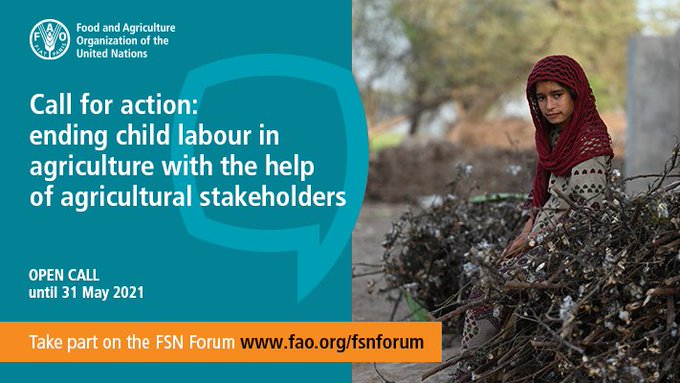The facilitator of this open call, Bernd Seiffert from FAO's Inclusive Rural Transformation and Gender Equity Division, has decided to extend the deadline until 14 June 2021 to give you some additional time to share your insights and suggestions with us.
2-3 November 2021. FAO high-level Global Event on Ending Child Labour in Agriculture
"12 June is World Day Against Child Labour. This year’s observance is particularly important, as 2021 is the International Year for the Elimination of Child Labour and the first World Day since the universal ratification of ILO Convention 182 on the Worst Forms of Child Labour. For the occasion, ILO and UNICEF will release the new global estimates on child labour (2016-2020), assessing the pace of progress towards ending child labour. It will be particularly important to look at the agriculture sector, where in the previous estimates 71% of all child labourers were found."
Related:
19 October 2021. 15:45-17:00 BST / 10:45 – 12:00 ET. CHILD LABOUR IN THE AGRICULTURAL SECTOR - Child Labour webinar series
Related:
15 May 2021. On the occasion of Europe Day, the EU Delegation in Rome organised a ‘Virtual Symposium on Ending Child Labour by 2025’, bringing together its partners to discuss the most critical challenges to accelerate progress towards meeting the SDG Target 8.7, the most pressing problems and barriers that need to be addressed, the impact of Covid-19, the key ingredients of successful partnerships, as well as how to inspire and scale up action on the way ahead.
The panellists reflected on different aspects of child labour - from agriculture and agri-food systems transformation, through human dignity, gender inequality, human rights to rural poverty and rural development - highlighting the complex nature of the issue. To effectively address child labour and deliver change, there is a need to develop a holistic and whole-of-supply-chain approach. In 2021, the focus needs to be on ‘scaling up’ action, matching commitments with tangible results. The international community must take immediate, concrete and effective action to find a way to come out of the scourge of child labour. The magnitude of this task requires cooperation at all levels and through all sectors. Breaking down siloes and forging strategic multistakeholder partnerships will be an essential step on the way forward.
The panellists reflected on different aspects of child labour - from agriculture and agri-food systems transformation, through human dignity, gender inequality, human rights to rural poverty and rural development - highlighting the complex nature of the issue. To effectively address child labour and deliver change, there is a need to develop a holistic and whole-of-supply-chain approach. In 2021, the focus needs to be on ‘scaling up’ action, matching commitments with tangible results. The international community must take immediate, concrete and effective action to find a way to come out of the scourge of child labour. The magnitude of this task requires cooperation at all levels and through all sectors. Breaking down siloes and forging strategic multistakeholder partnerships will be an essential step on the way forward.
- Alexandra Valkenburg, Ambassador of the European Union,
- Stefano Sannino, Secretary-General of the European External Action Service "The Team Europe approach testifies to the European Union’s global solidarity to support partner countries and assist the most vulnerable in line with the principle of leaving no one behind”,
- Gilbert F. Houngbo, President of the International Fund for Agricultural Development
- Cardinal Peter Turkson, Prefect of the Dicastery of Integral Human Development,
- Honourable Ignatius Baffour-Awuah, Minister of Labour and Employment Relations of Ghana
- Els Haelterman, Head of Partnerships and Fundraising of the IDH Sustainable Trade – Beyond Chocolate Partnership Initiative,
The video below starts at 39:00 "At the request of the Belgian government we convened in 2018 a partnership around a social and environmental sustainability (beyond) chocolate partnership. It also involves the Netherlands, Germany, Switzerland (...) We also support innovative projects." - Máximo Torero, Chief Economist of the UN Food and Agriculture Organization, underlined that progress towards ending child labour would depend on how successful we are in addressing the root causes of child labour in agriculture.
- Martin Seychell, Deputy Director-General for International Partnerships of the European Commission
“The biggest mistake we can make is to work in isolation. We need to identify the complexity of supply chains, all segments, actors, the prevalence of child labour and related risks. It is essential to understand the local context and to associate with the beneficiaries in all project phases”


No comments:
Post a Comment